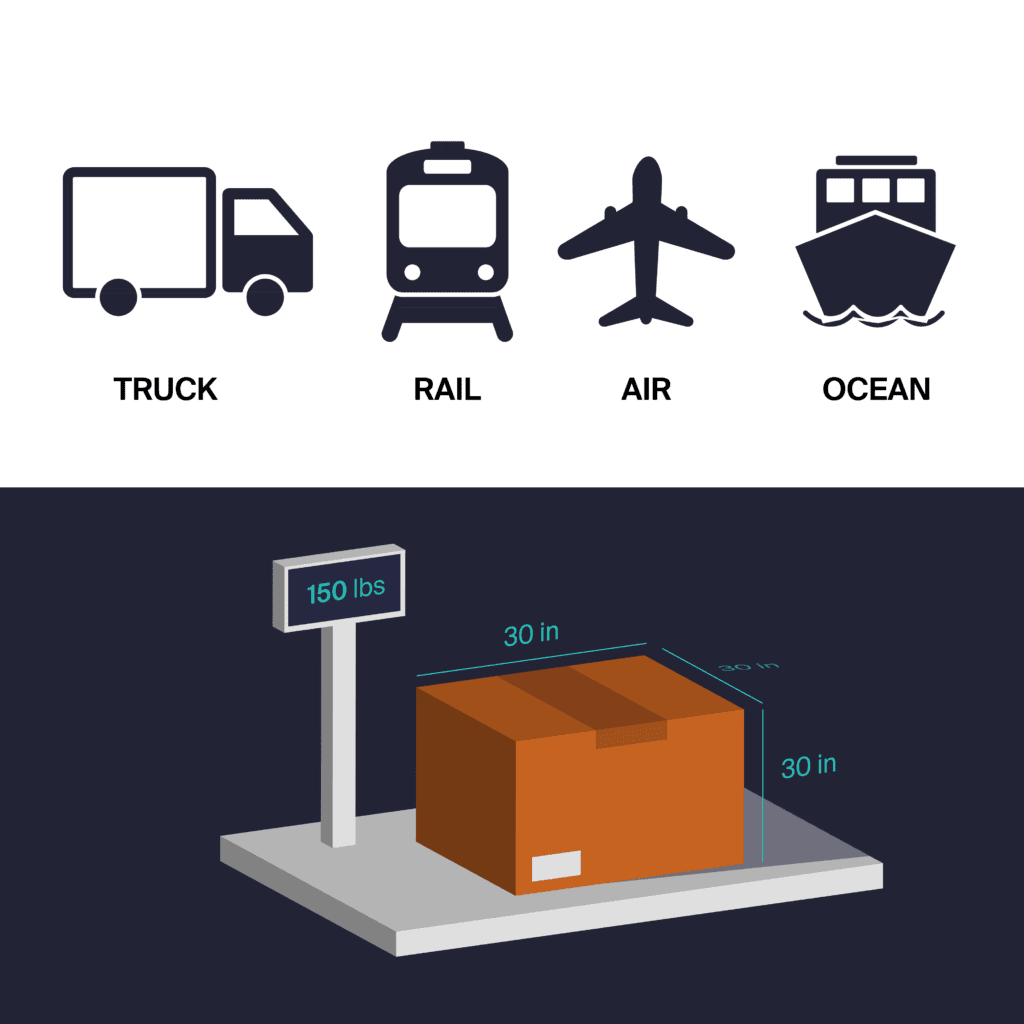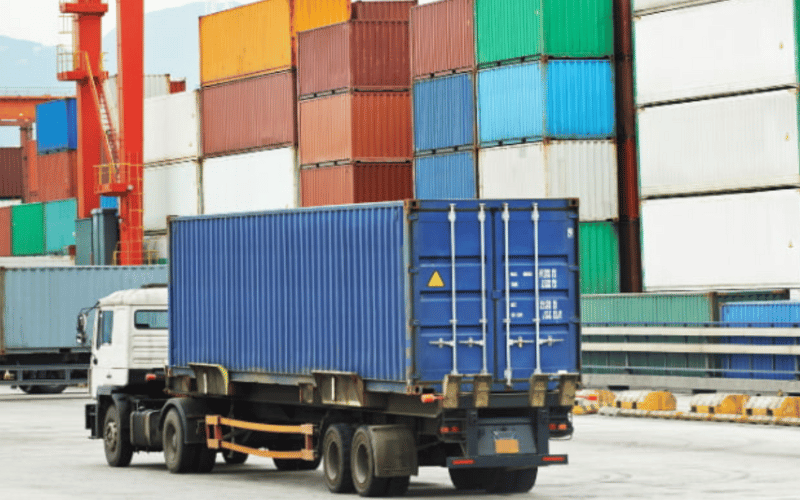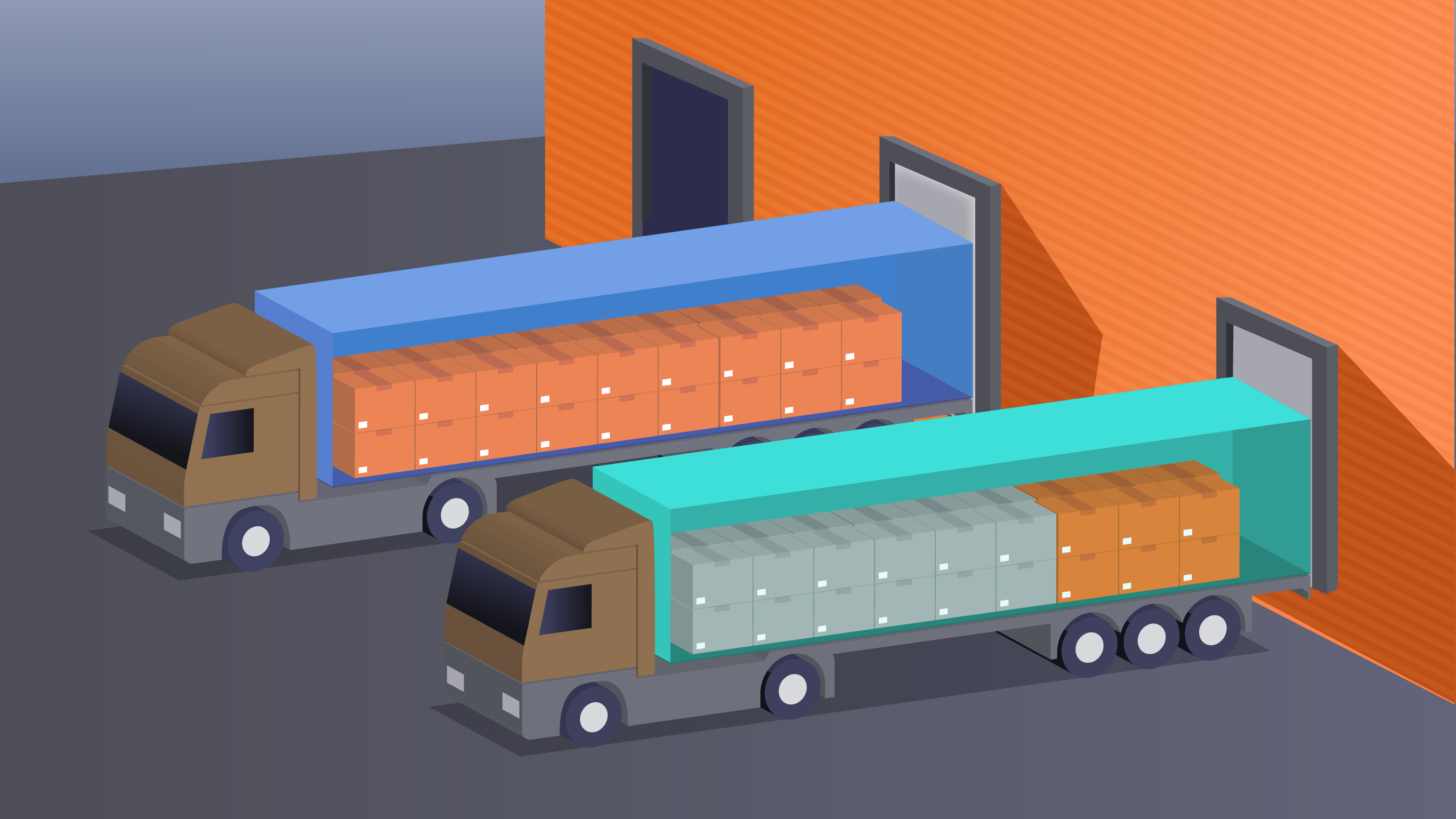Eighty percent of merchants’ supply chain costs increased in 2022, and 42% reported increased freight shipping rates as the primary cost driver.
Freight shipping is how most businesses get their goods from one place to another. It’s any movement of goods that weigh over 150 pounds.
As we discuss in our ebook, it’s all a part of winning customers over through timely and reliable delivery.
Freight shipping is a key part of any company’s supply chain. With the supply chain disruptions of the past years, it’s become an even more important issue for growing businesses that need to make deliveries on time consistently.
This guide contains everything you need to know about freight shipping and logistics so you can make informed decisions for your business.
Here, you can learn the difference between Less Than Truckload (LTL) and Full Truckload (FTL) freight shipping, how to find the best rates, and what services to expect from a freight provider.

What Is Freight Shipping?
Freight shipping transports large or heavy items via truck, rail, air, or ocean. This method is essential for merchants and retailers to distribute products to storage facilities, fulfillment centers, and stores. Single shipments qualify as freight if they weigh over 150 pounds or exceed dimensions of 30 x 30 x 30 inches.
Normally, freight shipping goes to storage facilities, fulfillment centers, and retail stores. However, eCommerce merchants shipping large products like exercise equipment or furniture are challenged to find a vendor to make freight shipments to residential locations. Changes in consumer behavior due to the pandemic have increased online shopping, with a significant number opting to buy bulky items online and valuing in-home delivery services.
Not only are customers doing more of their shopping online, but they’ve also changed their delivery preferences for online purchases. In a recent consumer survey, 70% said they would forego 1-2 day delivery for free shipping, and 93% said they would wait longer if it meant they could be sure the package would arrive when it was scheduled.

Types of Freight Shipping
There are 8 main freight shipping options. Pay attention to this list to determine which one fits your needs best. Each has its advantages and disadvantages, so you could use different options for different needs. Let’s unpack them all:
1. Full Truckload
Full Truckload (FTL) freight, also known as TL (Truckload) or OTR (over-the-road) is a method of freight shipping that uses a 53-inch semi-truck to transport products on surface roads. These shipments can cross state or country borders, and each truck can typically carry a maximum of 26 pallets.
A shipment is classified as FTL if the entire truck is filled with products from the same shipper; the shipment doesn’t necessarily have to take up the “full truck”. FTL shipments have one dedicated driver and stay on the same truck until they arrive at their final destination.

2. Less Than Truckload
Less Than Truckload (LTL) is also transported on a 53-inch semi-truck but with shipments from multiple shippers on the same truck. This means that the shipment price is shared across multiple shippers, but it also means that the driver’s time and resources are split among them.
LTL shipping networks are complex and require multiple touchpoints. This means more opportunities exist for lost or damaged shipments as they’re transferred between trucks.
LTL and FTL are the most common types of domestic freight shipments, and it can be difficult to determine which method is the best option. The chart below outlines the basic differences between LTL and FTL freight shipping. For a full breakdown of the differences, with tips and recommendations, see our complete guide to LTL vs FTL.

3. Partial Truckload
Partial Truckload (or PTL) is another way of transporting your freight on a 53-inch semi-truck. It’s suited for shipments that don’t require a full truck but are too large for traditional LTL, often taking up at least half of the truck’s capacity. Unlike LTL, PTL usually involves fewer shippers with larger loads. It also typically involves shipments with the same or nearby destinations.
PTL shipping enables your freight to remain on one truck for the entire transit duration, reducing the risk of misplacements. It also tends to be more flexible regarding scheduling than FTL since you don’t need to fill the entire trailer with your shipment before it can leave.
Because PTL involves less handling, it reduces the chances that your goods will be damaged. That makes Partial Truckload shipping a great option for shipments that are susceptible to damage.
4. Rail Shipping
Rail Shipping is a reliable method for transporting large volumes of goods over land, particularly across large, landlocked regions. Many businesses choose rail shipping for its cost efficiency compared to road transport, especially for heavy or bulk commodities, and it can operate round the clock.
Rail shipping offered predictable transit times and schedules before the global supply chain challenges that emerged in recent years. However, since 2020, the industry has faced its disruptions, including labor strikes and infrastructure malfunctions, which have introduced unpredictability into transit times.
Despite these challenges, rail remains a favored choice for its lower environmental impact and ability to transport substantial loads that are not time-sensitive.
Generally, rail shipping has a lower risk of accidents and emits fewer greenhouse gases, but it offers fewer options for delivery locations.
5. Ocean Freight
Ocean Freight is the most common method for transporting products internationally. Most merchants in the United States manufacture their products overseas, and ocean freight is the most economical method to transport them to the US.
Prior to pandemic-induced supply chain disruptions, it typically took around 40 days to ship a container from China to the US. Since 2020, the market has been volatile. Unexpected shutdowns and port congestion make it hard to estimate how long an ocean freight shipment will take, although it’s generally longer than air freight.
However, ocean freight is typically favored for shipments weighing over 100kg because it’s more cost-effective than air freight. For smaller amounts of goods, it isn’t sustainable.
6. Air Freight
Air Freight is in much higher demand since 2020 supply chain disruptions, which caused ocean freight rates to increase and transit times to increase. While passenger air travel was down, air freight rates became more competitive with ocean freight. However, air freight rates have a significantly higher carbon footprint than ocean freight.
The heightened demand for air freight has expanded the sector’s capabilities and services, including enhanced tracking and more direct routes to previously under-serviced locations. As businesses increasingly prioritize speed and reliability over cost, air freight is becoming an important part of global supply chains, particularly for industries like electronics and pharmaceuticals, where time sensitivity is critical.
All of that comes at a high cost, however, since air freight is typically among the most expensive options.
7. Intermodal Freight
Intermodal Freight is a versatile shipping method that combines two or more transportation modes — such as rail, truck, and sometimes ocean — to move goods using intermodal containers, also known as shipping containers or ISO containers.

This method capitalizes on the strengths of each transportation mode to achieve more cost-effective, efficient, and environmentally friendly results.
The key advantage of intermodal freight is the seamless transfer of containers between trucks, trains, and ships without the need to unload and reload the cargo at each transfer point. Intermodal freight keeps the goods in containers that meet international standards. This standardization reduces handling costs and minimizes the risk of damage during transit, enhancing overall supply chain security and reliability.
Additionally, by combining rail and ocean shipping for significant segments of the journey, intermodal shipping significantly reduces fuel consumption and greenhouse gas emissions compared to road-only transport.
Intermodal shipping also offers flexibility in managing logistics. It allows shippers to adjust routes and transportation modes in response to changes in cost, transit times, or environmental regulations. Intermodal freight continues to evolve, incorporating advanced technologies for better container tracking, optimized routing, and improved load management.
8. Specialized Freight
Specialized Freight shipping companies cater to unique shipping needs that standard methods cannot accommodate. This includes the transportation of oversized goods, which may require custom vehicles and routing to navigate size and weight restrictions. It can also be helpful for goods with unwieldy shapes that are flammable, hazardous, or have special requirements like agricultural goods and livestock.
Specialized Freight is also suitable for food and pharmaceuticals, maintaining specific temperatures throughout transit to ensure product integrity. White-glove freight services are specialized services that offer the highest level of care, providing delivery and handling, installation, and setup of high-value or sensitive items. This can also include expedited freight for time-critical shipments.
Each specialized service addresses specific challenges, ensuring safety, compliance, and customer satisfaction in transporting delicate or extraordinary cargo.
Freight Shipping Rates
Between high demand and a shortage of truck drivers, freight shipping rates have made their way even into mainstream media. Fluctuating diesel prices and ongoing supply chain volatility make freight shipping costs difficult to predict, but understanding what factors affect those rates will help you make better decisions for your business.
Over the Road (OTR) Freight Shipping Rates
OTR freight shipping rates are spot rates – meaning they can change dramatically based on the current market demand. Changes in the market and price fluctuations can happen overnight, and rates aren’t locked in until a pickup is scheduled.
LTL prices are determined primarily by the product’s freight class. Freight class is a numerical freight classification set by The National Motor Freight Traffic Association (NMFTA), which rates product types from 50 (the least expensive) to 500 (the most expensive). Shipments are categorized according to:
- Freight class
- Linear footage
- Weight
- Distance traveled
LTL freight rates are also affected by fuel surcharges. Fuel surcharges are set by The U.S. Department of Energy every Monday. The average price sets the standard for all freight shippers in the country.
Knowing your product’s freight class is an important part of getting an accurate LTL freight rate, and freight class is determined by product type, density, ease of handling, and more. For an in-depth look at freight class and helpful tips for LTL shippers, check out Coyote Logistics’ guide to LTL freight class or see our quick guide to freight classes here:

FTL rates are simpler to calculate because they don’t consider freight class or product type. The product type doesn’t affect the rate if the shipment can be covered by standard insurance and weighs less than 45,000 pounds.
FTL rates can be quoted as a price-per-mile or a flat door-to-door rate. While freight class doesn’t affect FTL pricing, several variables can cause prices to fluctuate, including:
- Seasonality: The holiday peak season and produce seasons are more expensive to ship freight.
- Mileage and trucking lane: Total distance traveled does play a part in FTL rates, but shipping from one high-demand city to another will cost more per mile due to capacity constraints.
- Timing/urgency: If you have flexibility on your pickup and delivery dates, you can usually find a lower rate.
- Pickup and dropoff location: Ease of access, scheduling, and equipment availability at the pickup and dropoff locations will affect FTL rates. The more difficult the locations are to access, the higher the rate will be.
- Contract vs. spot rates: Scheduling out and contracting regular FTL shipments gives carriers predictability, which is highly attractive and will often result in lower rates. Scheduling shipments at the last minute will typically result in higher rates.
- International vs. domestic: Another wrinkle that can affect freight shipping rates is whether you cross international borders with your shipment
If you want the best rates on your freight shipping, consider these points when making your choices.
International Freight Shipping
International freight shipping is any freight shipment that crosses an international border. For US merchants, that can mean importing goods from as far away as China or as near as Mexico. Regardless of the distance traveled, international freight shipping has some additional considerations to domestic freight shipping, including:
- Clearing customs (both export and import)
- Additional paperwork
- Transferring carriers
Air, ocean, rail, and truck freight shipping can be international. However, it depends on the specific legal and infrastructure connections between 2 nations—even bordering countries may not share convenient rail lines, or geography may impede overland shipping.

China is spending almost $1 trillion to improve its freight shipping connections through central Asia and isn’t even halfway through the project. That means you shouldn’t assume that the connections you’re looking for are necessarily present or up to the standards you’d expect.
Freight Brokers vs. Freight Forwarders
Freight brokers and freight forwarders are sometimes referred to as ‘middlemen,’ but a partnership with a well-resourced freight broker or freight forwarder can ease a lot of operational burden, especially for fast-growing brands.
At their core, freight brokers and freight forwarders act as intermediaries between shippers and carriers. They negotiate rates, schedule pickups and deliveries, track the shipment on its journey, notify shippers of shipment changes or delays, and more.
Some freight brokers can also act as freight forwarders or even carriers, but their functions have some key differences.
What Is a Freight Broker?
A freight broker is an intermediary who helps shippers and carriers arrange transportation without owning any vehicles themselves. They’re usually technology-based solutions with a deep portfolio of reliable shippers to call on, enabling them to provide competitive rates even when capacity is tight.
What Is a Freight Forwarder?
A freight forwarder is a firm that specializes in organizing and facilitating the shipment of goods on behalf of shippers, handling logistics and documentation needed for international transport. They’re different from brokers because they can take possession of the cargo to store, package, and consolidate it when necessary. Unlike freight brokers, freight forwarders can work across international borders for ground, ocean, ocean, or air freight shipments.
Because freight forwarders take possession of the products, often storing them in their warehouses, they assume a greater liability than freight brokers. They also package and can often consolidate shipments to negotiate better rates.
How to Find a Freight Shipping Provider
Ultimately, the qualities that make a great freight provider also make a great warehousing, fulfillment, and delivery partner. Segmenting your supply chain solutions among multiple partners can make the internal shipping process unwieldy and inefficient. Streamlining your end-to-end supply chain through a single partner gives you greater control over your business.
An end-to-end supply chain solution will have a consolidated technology platform to track your inventory from the manufacturer to your end customer through one access point. You’ll also have one point of contact for questions or issues you may encounter. This partnership can simplify day-to-day operations, giving you back time and resources to invest in other areas of your business.
Having a single provider will also give you visibility into your supply chain to more easily identify opportunities for greater efficiencies or cost savings. Your data is aggregated in a single platform and reporting system so that it tells more compelling stories about the effect your supply chain has on the entirety of your business.
If you’re looking for an end-to-end supply chain partner to simplify your business, contact one of our supply chain experts.
Freight Shipping FAQs
Here are some answers to commonly asked questions about freight shipping.
How Much Does Freight Shipping Cost?
Freight shipping costs are determined by various factors. LTL rates change quickly and are often based on capacity (a spot market). LTL rates are determined primarily by freight class. FTL costs are often determined by cost per mile traveled. FTL rate quotes are more reliable but more expensive than LTL rates on average.
How Long Does Freight Shipping Take?
Due to the complex nature of LTL networks, LTL shipments will take longer than FTL shipments and don’t have scheduled delivery time. FTL shipments take a direct route from their origin to their destination. Their delivery times can be limited by weather, traffic, and the number of hours the driver is legally allowed to drive at a time.
What Is a Freight Handler?
Freight handlers do the heavy lifting of loading, unloading, packing, labeling, and consolidating freight along different steps of its journey. They are responsible for keeping records and ensuring the safety of goods as they travel through a freight network.
What Is a Freight Dispatcher?
A freight dispatcher works on a freight carrier’s team to communicate with freight brokers and help drivers schedule their loads. They’re essential for effectively managing shipments and ensuring on-time delivery.
What Is Multi-Modal Freight Shipping?
Multimodal refers to different modes of transport along the same cargo route or within the same network. For example, a multimodal network may include ocean, air, rail, and over-the-road transportation.
What Is Transloading?
Common in long-haul containerized transportation, transloading is the process of transferring a shipment from one mode of transportation, such as an airplane or ship, to another, like truck or rail, to reach its end destination. Learn more about transloading services and the essential role they play during supply chain disruptions.
How Do You Get Started with Freight Shipping?
With all of these factors and options to consider, it’s easy to get overwhelmed. Don’t worry. It isn’t that tough to start, even if you’re just learning about freight shipping.
Hopefully, this guide has given you some idea of what you’re looking for. But if you want to figure out all the details, the best way forward is to talk to our team.




